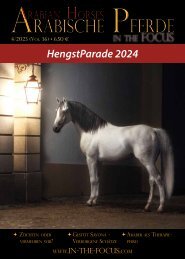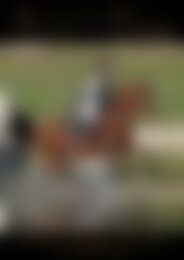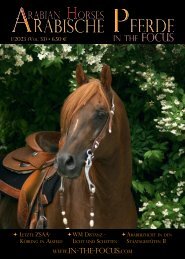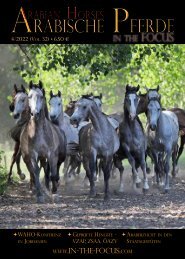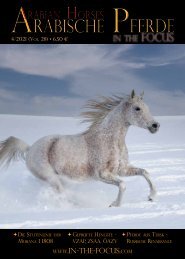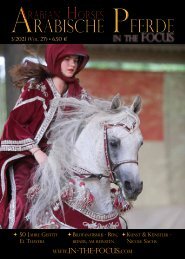Arabische Pferde IN THE FOCUS Nr. 1/2020 (Vol. 21) - Preview
Die Zeitschrift für Freunde und Züchter arabischer Pferde
Die Zeitschrift für Freunde und Züchter arabischer Pferde
Sie wollen auch ein ePaper? Erhöhen Sie die Reichweite Ihrer Titel.
YUMPU macht aus Druck-PDFs automatisch weboptimierte ePaper, die Google liebt.
History<br />
tified products, Dénousté died at 27 years old,<br />
having kept his flexibility and fertility!<br />
Impressed by the French racing Arabs, the<br />
Russian government sent a buying mission to<br />
the Southwest of France in the 1930s… this<br />
is how a son of Dénousté (together with six<br />
mares, among them Aissa, tailing back to Asfoura),<br />
Kann, went to Russia… Crabbet mares<br />
were also imported to Russia and Kann's<br />
marriage to one of them (Rixalina) gave the<br />
heroic Korej, who endured the migrations<br />
and vicissitudes of the Second World War and<br />
remained brilliant until his death at almost<br />
30 years old… he left Tersk with prestigious<br />
descendants: Knippel, the big winner on the<br />
flat, and Kankan (closely inbred with Rixalina<br />
as a double grandmother), the father of the<br />
legend Persik!<br />
The North African Outlets<br />
French Arabian breeding owes a lot to the races<br />
reserved for it and which were very popular<br />
with big owners, until the looming of the<br />
Second World War. After this, the number of<br />
Arab horses was in free fall in the countries<br />
of the Cradle: the armies of the whole world<br />
are motorized, many nomads settle down<br />
and prefer the car to the horse ... the local<br />
natural selection is definitely compromised.<br />
Fortunately the English were able to organize<br />
in Egypt an efficient selection body, the Royal<br />
Agricultural Society.<br />
For France remain the studs and stallion depots<br />
of North Africa, however all the work of<br />
selection carried out in Tiaret (in particular<br />
by the commander Bardot with respect to<br />
Bango) will be almost reduced to nil in fifteen<br />
years, with the use of poor standards and a<br />
policy of dispersal. In Tunisia, excellent racing<br />
Arabs are still produced, of native or French<br />
strains, notably Sumeyr and Ourour. After 5<br />
victories in Tunisia Ourour arrives in service<br />
at Tarbes at 5 years old in 1952. He was little<br />
used in purebred Arabians (only 18 foals in 17<br />
years of service, in the worst years of decline,<br />
but what quality!). We find Asfoura as damline<br />
and through his father Duc, Ourour traces<br />
to both, Merjané and Warda.<br />
The immense genetic potential of French<br />
North African establishments have been<br />
dispersed during the political events which<br />
accompany the independence of these<br />
countries. In 1964 the studbook commission<br />
admits some mares repatriated from<br />
North Africa and the administration acquires<br />
three stallions typical and regular in races:<br />
In'Chaalah, Iricho and Irmak… despised by<br />
Anglo-Arab breeders who prefer Ba-Toustem<br />
or Saint Laurent, more consistent models.<br />
French Arabian horses are in the process of<br />
Djerba Oua (Dragon / Doree II) *1946 is inbred three times in III. generation to Dénousté. Through<br />
his son Gosse de Bearn (but not only him), he had great influence on French Arabian breeding.<br />
Dénousté (Latif db / Djaima (von Khouri db)) *19<strong>21</strong>, one of the most influential stallions; he had<br />
ca. 450 foals, though not all of them purebred Arabians.<br />
disappearing, yet the National Stud of Pompadour<br />
still has a few purebred Arabian broodmares…<br />
Unfortunately in the 1960s, they<br />
only produce Anglo-Arabs as do most private<br />
broodmares: Maderba , Madonna, Magicienne,<br />
Nevada II etc have produced more in<br />
crossbreeding than in the purebred Arabian<br />
breed which leaves us today with immense<br />
regrets: Nevada II, remember, grandmother<br />
in female line of at least 50 Group 1 winners<br />
and, associated with Ourour, mother of Nevadour,<br />
one of the most sought after strains<br />
in the world, "the mare of a lifetime" by Renée<br />
Laure Koch.<br />
The Depression<br />
In 1965, the studbook recorded only two<br />
purebred Arabian foals. One of them comes<br />
from Robert Mauvy, esthete, painter and<br />
breeder of Arabian horses according to the<br />
lineages and customs of the cradle. Then Jacques<br />
Chalom des Cordes set up in 1966 in Provence<br />
a breeding program with Polish Arabians,<br />
much more "beautiful" than ours and<br />
selected however at the races. The latter will<br />
soon be emulated, new studs are flourishing<br />
and importing horses from Poland, Tunisia,<br />
Holland, Morocco - new, the calibration has<br />
become private! It was the time when these<br />
new breeders rebelled against the National<br />
stud farms that they accused of reducing the<br />
Arabian horse to a mere henchman for the<br />
Anglos.<br />
Promoted director of Pompadour, Pierre<br />
Pechdo, personally very favorable to this revival<br />
in favor of the Arab, was sent on a mission<br />
in 1970 to Poland in order to acquire three<br />
stallions. As most of the good subjects were<br />
reserved for the auction where the Americans<br />
buy them at gold prices, negotiations were<br />
difficult but he managed to acquire Baj (by<br />
Negatiw, damline Gazella II), Elaborat and<br />
Badr- Bedur, both by Comet whose ancestor<br />
46<br />
© ARABISCHE PFERDE - <strong>IN</strong> <strong>THE</strong> <strong>FOCUS</strong> 1/<strong>2020</strong>



